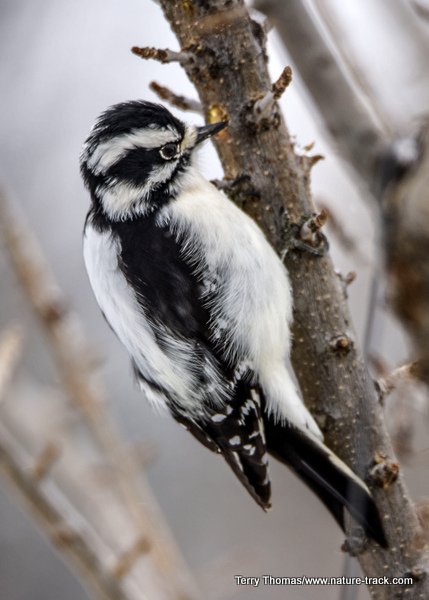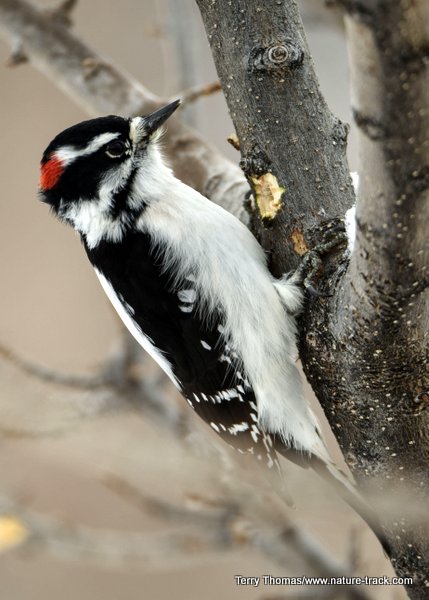Downy Woodpeckers


The downy woodpecker is a common backyard bird at feeding stations. The female downy woodpecker is on the left, the male on the right.
The birdfeeders sat empty for several weeks while we were out of town and it took a few days for the birds to re-discover them once we returned. Then in one morning, we had red-breasted nuthatches, black-capped chickadees, house finches and a male downy woodpecker all hanging around the feeders at once.
We had seen the female downy woodpecker occasionally during the summer so we knew she was hanging around, but this was the first time we had seen the male since spring. He spent most of his time checking the tree trunks around the feeders hoping to find a few insects tucked inside the bark.
Downy woodpeckers are the most common woodpecker to visit backyards. Since they don’t migrate, they can provide entertainment throughout the year and hanging bird feeders (blackoil sunflower seed and peanuts are favorites) and suet blocks is an almost sure way of encouraging them to visit your yard.
Downy woodpeckers are the smallest North American woodpeckers. They are about the size of a house sparrow with a six-inch long body and a ten-inch wingspan. This small size helps them to take advantage of resources other woodpeckers are too big to use. You can often see downy woodpeckers on weed stems pecking at larva-containing galls or searching for insects among bark on tiny branches.
The sexes of the downy woodpecker are similar: black wings with white spots and black and white barred heads. The chest and back are white and an oblong white patch shows in the middle of their back when the wings are folded. Males do sport a red spot on the back of the head and juveniles have a red crown.
These tiny woodpeckers are real charmers. They are cute and energetic—seemingly constantly on the move. More than most woodpeckers, they race across and even down trunks when searching for food. They fly with the up-down undulating flight typical of woodpeckers where a few wingbeats are followed by wings folded against the body.
Downy woodpeckers have a short high-pitched pik pik pik call that when run together is called a whinny. They don’t sing a mating song, but rather, like most woodpeckers, use drumming on trees as their mating call. Both sexes drum a rapid even-toned beat that attracts mates and signals readiness for breeding.
One of the first identification challenges new birders face is learning to tell the downy woodpecker from its larger cousin, the hairy woodpecker. Side by side it isn’t hard as the downy is a third smaller than the hairy woodpecker. Individually though, it is a different story. The best way to tell is to compare the bill to the rest of the head. On the downy, the bill is about half the depth of the rest of the head. The bill on the hairy woodpecker nearly equals the depth of the rest of the head and is stouter.
Downy woodpeckers are considered numerous and widespread. They are found in every state but Hawaii and all but the northernmost Canadian provinces.
These diminutive woodpeckers are nearly completely beneficial birds. Many of the insects they eat are considered forest or garden pests and the holes they create for nests and during feeding also serve later as nesting cavities for birds such as the mountain bluebird.
Despite the fact that they are common birds, I still look forward to seeing the downy woodpeckers this winter. I am happy to trade a little suet and peanuts to watch them. Their antics add color in an otherwise sleepy world.

Help Idaho Wildlife
When we traveled across the state in October 2017, most of the vehicles we saw using the wildlife management areas did not have wildlife plates. Buying wildlife plates is a great way for non-hunters and hunters alike to support wildlife-based recreation like birding.
C'mon folks, let's help Idaho's wildlife by proudly buying and displaying a wildlife license plate on each of our vehicles!
See below for information on Idaho plates. Most states have wildlife plates so if you live outside Idaho, check with your state's wildlife department or vehicle licensing division for availability of state wildlife plates where you live.
And tell them that you heard about it from Nature-track.com!
Wildlife License Plates
Great news! as of 2024, there are three NEW designs for license plates. They still are bluebird, cutthroat trout and elk, but they are beautiful.
Idaho Wildlife license plates provide essential funding that benefits the great diversity of native plants and wildlife that are not hunted, fished or trapped—over 10,000 species or 98% of Idaho’s species diversity. Game species that share the same habitats (such as elk, deer, antelope, sage-grouse, salmon, trout) also benefit from these specialty plates.
No state tax dollars are provided for wildlife diversity, conservation education and recreation programs. Neither are any revenues from the sale of hunting or fishing licenses spent on nongame species. Instead, these species depend on direct donations, federal grants, fundraising initiatives—and the Idaho Wildlife license plates.
Both my vehicles have Bluebird Plates. I prefer the bluebird because the nongame program gets 70 percent of the money from bluebird plates, but only 60 percent of the money from elk and trout plates - 10 percent of the money from elk plates supports wildlife disease monitoring and testing programs (to benefit the livestock industry) and 10 percent from cutthroat plates supports non-motorized boat access.
Incidentally, in 2014, the Idaho Legislature denied the Department of Fish and Game the ability to add new plates or even to change the name of the elk and cutthroat plates (very specific) to wildlife and fish plates, a move that would have allowed for changing images occasionally and generating more revenue. It would seem that they believe that we Idahoans don't want a well funded wildlife program.
I think it is time we let the Legislature know that Idahoan support wildlife funding and that we would like to see these generic plates come to fruition.

"WOW. What a phenomenal piece you wrote. You are amazing." Jennifer Jackson
That is embarrassing, but actually a fairly typical response to my nature essays. Since The Best of Nature is created from the very best of 16 years of these nature essays published weekly in the Idaho Falls Post Register (online readership 70,000), it is a fine read. It covers a wide variety of topics including humorous glimpses of nature, philosophy, natural history, and conservation. Readers praise the style, breadth of subject matter and my ability to communicate complex and emotional topics in a relaxed and understandable manner.
Everyone can find something to love in this book. From teenagers to octogenarians, from the coffee shop to the school room, these nature essays are widely read and enjoyed.
Some of the essays here are my personal favorites, others seemed to strike a chord with readers. Most have an important message or lesson that will resonate with you. They are written with a goal to simultaneously entertain and educate about the wonderful workings of nature. Some will make you laugh out loud and others will bring a tear to the eye and warm your heart.
Readers Write:
"You hit a home run with your article on, Big Questions in Nature. It should be required reading for everyone who has lost touch with nature...great job!" Joe Chapman
"We enjoyed your column, Bloom Where Planted. Some of the best writing yet. The Post Register is fortunate to have your weekly columns." Lou Griffin.
To read more and to order a copy, click here or get the Kindle version
Copies are also available at:
Post Register
Island Park Builders Supply (upstairs)
Barnes and Noble in Idaho Falls
Harriman State Park, Island Park
Museum of Idaho
Valley Books, Jackson Wyoming
Avocet Corner Bookstore, Bear River National Wildlife Refuge, Brigham City, Utah
Craters of the Moon National Monument Bookstore, Arco, Idaho